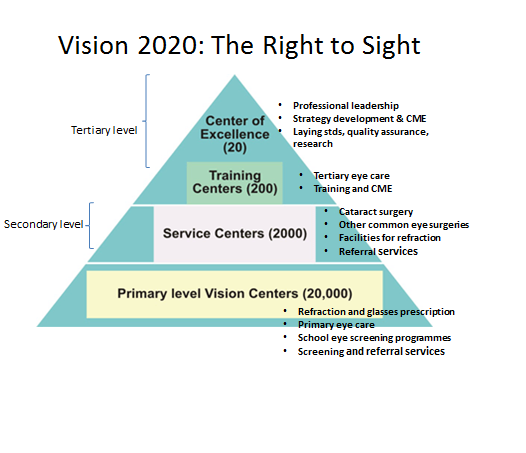
Blindness is not just a medical condition—it’s a life-changing challenge that impacts millions globally. It refers to complete or partial loss of vision, affecting a person’s ability to perform daily tasks, communicate, and live independently.
According to WHO “visual acuity of less than 3/60 (Snellen) or its equivalent“ is vision loss.
Blindness classified into 2 forms according to distance :
Distance vision impairment:
•Mild – Presenting visual acuity worse than 6/12
•Moderate – Presenting visual acuity worse than 6/18
•Severe – Presenting visual acuity worse than 6/60
•vision loss – Presenting visual acuity worse than 3/60
Near vision impairment :
Presenting near vision acuity worse than N6 or N8 at 40 cm with existing correction.
Global Impact
•According to the WHO, at least 2.2 billion people worldwide have a visual impairment.
•Out of these, around 43 million are completely blind,188.5 million have mild vision impairment 217 million have moderate to severe vision impairment.
•826 million people live with a near vision impairment.
•Shockingly, 80% of vision loss is preventable or treatable, especially in developing nations.
Cause of blindness:
The major causes of moderate to severe vision impairment are as follows:
1. Uncorrected refractive errors, 53 per cent;
2. Un-operated cataract, 25 per cent;
3. Age-related macular degeneration, 4 per cent;
4. Glaucoma, 2 per cent; and
5. Diabetic retinopathy 1 per cent.
The major causes of vision loss are.
1. Un-operated cataract 35 per cent;
2. Un-corrected refractive error 21 per cent; and
3 . Glaucoma 8 per cent.
In South-East Asia Region, cataract is the single most common cause of vision loss being responsible for 50-80 per cent of all blindness.
Preventable causes are: cataract, glaucoma, refractive error, trachoma, diabetic retinopathy etc.
Non preventable are: Retinitis pigmentosa, optic atrophy, congenital anomalies, genetic anomalies, age related macular degeneration etc.
Childhood Blindness
•A major concern in low-income countries.
•Causes are xerophthalmia, congenital cataract, congenital glaucoma and optic atrophy due to meningitis, relinopathy of prematurity, and uncorrected refractive errors. Xerophthalmia is largely under control with vitamin A distribution in immunization programmes.
•Early screening and treatment can prevent lifelong disability.
Blindness in India – Prevalence & Statistics
The prevalence of blindness according to rapid national survey on vision loss 2006-2007 was 1.0 per cent. In the current survey (2015-2018) the projected prevalence rate is 0.45 per cent.

Diagnosis & Screening
•Visual acuity tests
•Fundoscopy
•Tonometry for glaucoma
•Regular eye check-ups from early childhood, Blood pressure checkups especially for diabetics and elderly, are crucial.
Prevention:
•Primary care: xeropthalmia, trachoma should be treated by healthcare worker in villages.
•Secondary care: Provided help of cataract, glaucoma by PHC’s, District hosp. through eye camps.
•Tertiary care: opthalmic surgeries, corneal grafting etc. at district hospitals.
•Specific programs: like trachoma control program, Vit A prophylaxis- 200000 IU of vitamin A given orally at 6 month interval between age of 1-6 yr.
•Vision 2020 right to sight initiated by WHO which aims to reduce vision loss from 75 to 25 million people by the year 2020
Proposed Structure of Vision 2020:

DISEASE INCLUDED under vision 2020:
1.Cataract
2.Childhood blindness
3.Onchocerciasis
4.Refractive error
5.Trachoma
STRATEGIES:
•Disease prevention and control
•Training of personnel
•Strenthening eye care structure
•Use of appropriate & affordable technology
•Mobilization of resources
Treatment & Rehabilitation
•Cataract surgery restores sight in most cases.
•Corrective lenses for refractive errors.
•Laser therapy for diabetic retinopathy.
•Braille education, assistive tech, and mobility training improve quality of life.
Blindness and the Brain
Interestingly, blind individuals often develop enhanced auditory and tactile perception. The brain adapts, using other senses to interpret the environment—a beautiful example of neuroplasticity.
vision loss doesn’t mean darkness—it means living differently, not less. With support, empathy, accessibility, and awareness, we can make the world inclusive for the visually impaired.
Call-To-Action
“Blindness doesn’t have to mean the end of a fulfilling life. Share this article to raise awareness — and let’s work together to prevent avoidable vision loss.”
external Links (High Authority)
Internal Links (To Boost SEO)
- “Tingling and Numbness: 5 Shocking Warning Signs You Must Know“ (Neurological link)
- “Ozempic vs Wegovy: The Shocking Truth You Need to Know“ (Chronic disease link)
